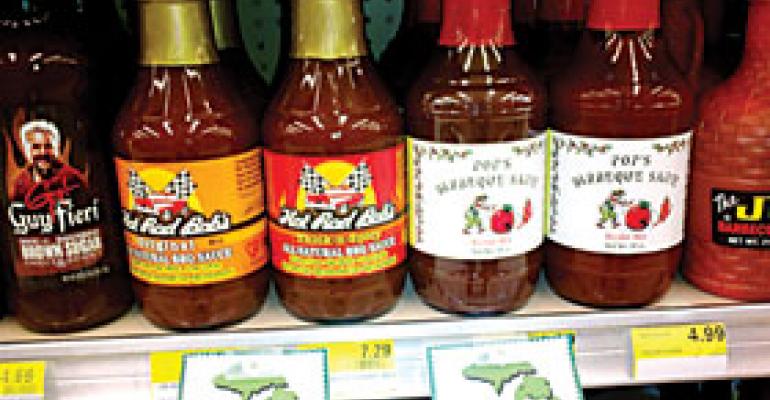Sales of specialty sauces and seasonings have soared in recent years, despite the sluggish economy. Some industry participants attribute this phenomenon to an ever-increasing demand for local products. Others believe it's because shoppers have been eating out less and cooking more at home.

Whatever the reason, the hottest new sauces and seasonings are region-centric and chock full of unique ingredients.
At Detroit-based Hiller's Markets, shoppers routinely choose local sauces and seasonings over national brands. They opt for in-state items even more when economic conditions are poor, said Justin Hiller, vice president of the seven-store chain.
“People understand that we are responsible for getting ourselves out of a financial crisis, so they consciously choose local products to help put money back into our economy,” he told SN. “If we stock a locally made brand of brine next to a national brine for instance, many of our shoppers will choose the local one. The same goes for other specialty seasonings and sauces made in Michigan.”
Sweet Sass Flavor Sauce (barbecue), Barlow's Gourmet Roasting, Grilling and Dipping Sauces, Tasha's Curry in a Hurry, Matt's Mix All Purpose Seasoning and Michigan's Own Zip Sauce are just a few of the locally produced items that sell well at Hiller's.
Of course, the supermarket also stocks items made elsewhere. Shopper favorites include Tropical Pepper Co. products in exotic blends like Papaya Curry sauce, Mango Coconut Sauce and Island Jerk Seasoning. Soy Vay Veri Veri Teriyaki is also popular there.
Ron Tanner, spokesman for the New York-based National Association for the Specialty Food Trade, agrees that the trend toward local is one reason that sales went up in recent years. He also cited several other possible causes.
“One of the big things that happened during 2008 and 2009 was that people cooked more at home. As they did, they bought specialty sauces and seasonings to recreate the full flavors they would get at restaurants if they were eating out,” said Tanner. “You also can't rule out the people who have come to enjoy the high quality of specialty products and refuse to stop buying them, even if the prices are slightly higher, even during rough financial periods.”
According to NASFT's State of the Specialty Food Industry 2011 report, sales of specialty seasonings were up 13.2% between 2008 and 2010, bumping them to 23.4% of total seasoning sales.
Both specialty sauces and seasonings fared well enough for manufacturers to continue making investments. According to the report, 169 new items were introduced to the category during 2010 compared with 107 new products in 2009 and 132 in 2008.
“Consumers are learning a lot about cooking from the Food Network, food magazines and the Internet, and they want to try making similar foods themselves,” said Roger McElroy, grocery buyer for Straub's Fine Grocers, St. Louis. “As they experiment, they are attracted to products with unusual ingredients, like one of the barbecue sauces we carry from a local restaurant, 17th Street BBQ, which has mustard as its base instead of catsup.”
Straub's also carries a traditional-flavored barbecue sauce made by 17th Street BBQ, plus the restaurant's self-branded Magic Dust grill seasoning. Missouri-made Uncle Bob's sauces and seasonings and Rivertown Rib Rub often outperform mainstream products. National products like Tyler Florence Rubs and Pike Place Fish Market rubs and seasonings are popular too, said McElroy.
Unexpected ingredients are popping up in all sorts of mixtures, said Sharon Grossetti, specialty food buyer, Woodlands Market, a small gourmet supermarket chain based in Kentfield, Calif.
“As soon as something starts capturing consumers' attention, whether it's an ingredient they hear about on TV, in magazines or by word-of-mouth, it ends up in a sauce or seasoning mix,” said Grossetti. “Coffee, green tea and cocoa is now in rubs and everybody suddenly has to have pomegranate. Pomegranate molasses is wildly popular with our shoppers.”
Some sauces and seasonings even have cinnamon, vanilla and an array of colored salts, like pink-hued hibiscus sea salt, she added.
Many of these unique flavor combinations are inspired by certain parts of the world. Grossetti has witnessed a growing interest in foods that hail from Morocco and Vietnam.
Many new specialty sauces and seasonings are not just identified by country, though. The precise flavor profile of a region is touted on the label, said Tanner.
“Instead of ‘Indian,’ a seasoning packet or bottle of sauce might say ‘Punjab’ or ‘Delhi,’” he told SN. “People are starting to understand that each region of a country has different cuisine, just like we have Southwestern, Southern and other regional fair in the U.S.”
Monrovia, Calif.-based Trader Joe's has its own brand of Punjab Spinach Sauce, plus Trader Joe's Pinjur Sauce, a flavor indicative of Eastern European nations like Macedonia. It also sells Trader Joe's California Roasted Garlic Powder and a product made by Tone's called “Louisiana Style Cajun Spice Seasoning.”
McCormick boasts an array of geographically focused SKUs as well. The company has Carolina Country Grill Mates marinade mix, Caribbean Citrus Seafood marinade mix, Santa Fe Style Seafood Sauce, Cajun Style Seafood Sauce and an entire line of California Style spice blends in varieties such as Garlic Powder with Parsley and Lemon Pepper with Garlic and Onion.
Retailers are planning their sets around ethnicities served.
“Winn-Dixie and Publix don't just carry regional sauces and seasonings, they have done a great job customizing their assortments to shoppers of different ethnicities,” said Jim Wisner, president, Wisner Marketing Group, Libertyville, Ill. “In Miami, for instance, a Publix store in a Cuban neighborhood might have mojo sauce while a Publix in an Argentinean area would have Chimichurri sauce.”
Savvy supermarkets are making it even easier for shoppers to sample the various specialty sauces and seasonings by slathering them onto steaks, kebabs, fish filets and shrimp, and selling them in self- and full-service meat and seafood departments. If nothing else, retailers should consider cross-merchandising a few bottles or packets in these areas of the store, added Wisner.





